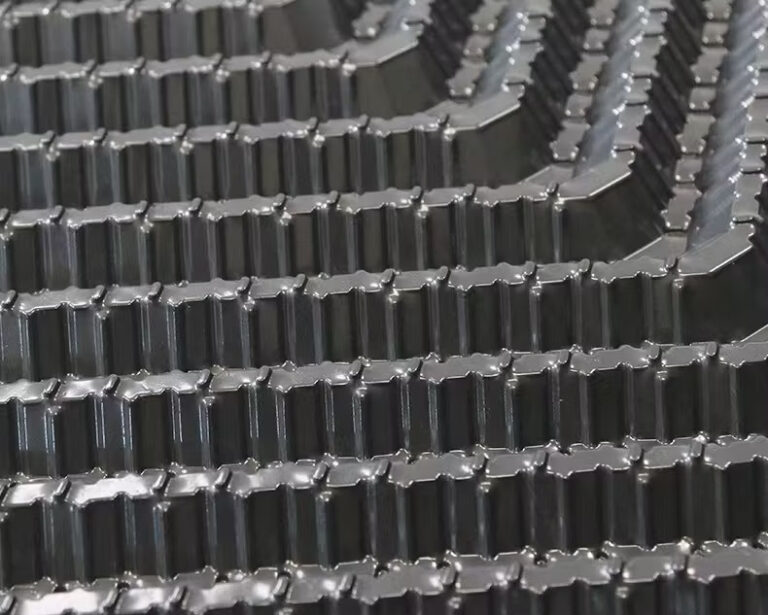Introduction
Splash fill media is a specialized component of cooling tower systems that ensures optimal heat dissipation by breaking water into small droplets, maximizing surface area for heat exchange. This process drives the efficiency of cooling towers, making splash fill media a vital choice for industries with heavy cooling demands. Below, we delve into the technical, operational, and innovative aspects of splash fill media, offering a thorough understanding. Splash fill media works on the principle of increasing water-air interaction to enhance evaporative cooling. When water flows through the cooling tower, the splash fill media disrupts the water stream, converting it into fine droplets. These droplets expose a larger surface area to airflow, enabling efficient heat transfer. The turbulence created ensures even water distribution, reducing stagnant areas and improving cooling performance.
Design and Materials
- Structural Configuration
- Grids and Slats: Arranged in layers, grids and slats create a zigzag pattern, forcing water to repeatedly break apart.
- Layered Modules: Stackable modules provide flexibility in tower design and maintenance.
- Open Channels: Wide gaps prevent clogging and ensure a free flow of water and air.
- Materials Used
- Polypropylene (PP): Known for high chemical resistance and lightweight properties.
- Polyvinyl Chloride (PVC): A cost-effective option, suitable for environments with moderate temperatures.
- Fiberglass Reinforced Plastics (FRP): Offers exceptional durability and resistance to extreme conditions.
- Aluminum and Stainless Steel: Occasionally used in specialized or high-temperature applications.
- Coating Technologies
- UV-Resistant Coatings: Protects against long-term sunlight exposure.
- Anti-Fouling Layers: Minimize the buildup of scale, algae, and other impurities.
Advantages of Splash Fill Media
- Efficient Heat Transfer
- The design optimizes droplet formation, enhancing air-water interaction for superior cooling efficiency.
- Versatile Applications
- Performs well in varied conditions, including dirty water, high temperatures, and environments with aggressive chemicals.
- Long-Term Durability
- Engineered to resist wear and tear from water flow, chemical exposure, and mechanical stress.
- Low Maintenance Requirements
- Open structure and self-cleaning properties reduce maintenance frequency and costs.
- Energy Efficiency
- The reduced pressure drop lowers the energy consumption of fans and pumps, contributing to cost savings.
Applications Across Industries
- Power Generation:
- Handles the cooling of turbine exhaust steam and other high-temperature processes.
- Chemical and Petrochemical Plants:
- Works effectively with water contaminated by oil, chemicals, or particulate matter.
- HVAC Systems:
- Commonly used in large-scale commercial and industrial HVAC cooling towers.
- Steel and Metal Industries:
- Provides efficient cooling for furnaces and heat-intensive processes.
- Food and Beverage Processing:
- Ensures clean cooling for processes requiring strict hygiene standards.
- Mining Operations:
- Handles abrasive particulates and high sediment levels in mining water.
Innovative Features
- Advanced Turbulence Mechanisms
- New designs create enhanced turbulence, ensuring that every droplet of water interacts thoroughly with the airflow.
- Hybrid Fill Systems
- Combines splash fill and film fill technologies for applications requiring both high surface area and clog resistance.
- Eco-Friendly Developments
- Use of recycled materials and biodegradable options for environmentally conscious industries.
- High-Temperature Tolerance
- Modern materials can withstand higher operating temperatures, expanding the range of suitable applications.
- IoT Integration
- Sensors monitor water flow, droplet size, and system efficiency in real-time, enabling predictive maintenance and reducing downtime.
Challenges and Mitigations
- Scaling and Fouling
- While splash fills are more resistant to fouling than film fills, high scaling environments may require periodic cleaning.
- Solution: Anti-fouling coatings and open-channel designs help mitigate this issue.
- Material Degradation
- Prolonged exposure to harsh chemicals or UV rays can reduce lifespan.
- Solution: Use advanced materials like FRP or coatings to increase durability.
- Installation Challenges
- Retrofitting older towers can sometimes require structural adjustments.
- Solution: Modular designs simplify installation and retrofitting processes.
Future Trends in Splash Fill Media
- Customization for Industry Needs
- Tailored designs for specific industrial processes, such as enhanced aerodynamics for low-energy systems.
- Sustainable Solutions
- Increased use of sustainable materials and waste-reducing manufacturing methods.
- Enhanced Thermal Performance
- Designs that integrate Computational Fluid Dynamics (CFD) to optimize cooling efficiency further.
- Lightweight and Modular Configurations
- Development of ultra-lightweight materials that reduce overall cooling tower weight and simplify transport and installation.
- Corrosion-Resistant Options
- Advanced alloys and coatings to handle aggressive cooling water chemistries.
Conclusion
Splash fill media is a cornerstone technology in the cooling tower industry, designed to maximize heat transfer efficiency through enhanced water-air interaction. Its robust design, versatility, and adaptability to varying operating conditions make it an ideal choice for industries requiring efficient and reliable cooling solutions. With advancements in materials, eco-friendly options, and innovative designs like hybrid systems and IoT integration, splash fill media continues to evolve, addressing modern challenges such as energy efficiency, durability, and environmental sustainability. Its role in improving the performance and longevity of cooling towers solidifies its importance in thermal management applications across diverse industrial sectors. As industries increasingly prioritize efficiency and sustainability, splash fill media stands out as a key contributor to meeting these goals effectively.

